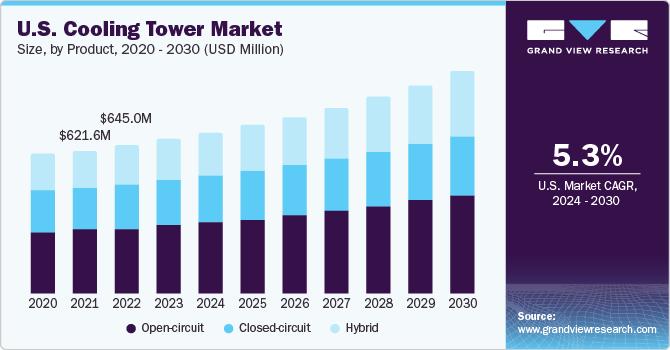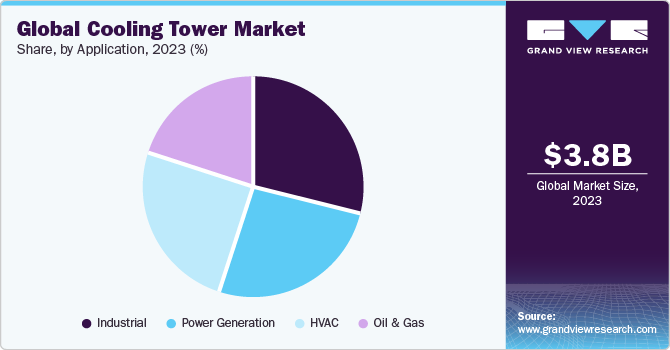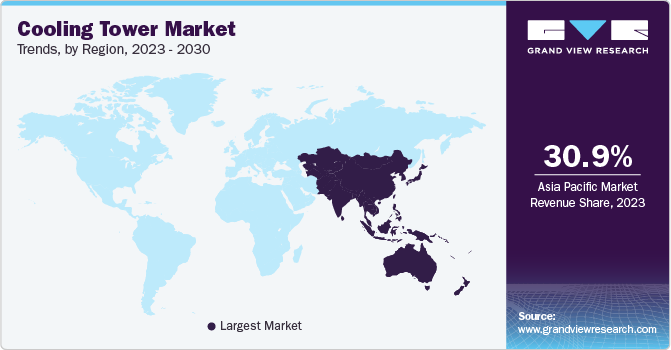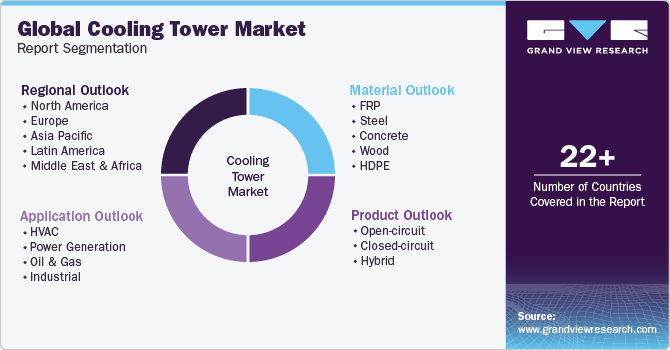- Home
- »
- Advanced Interior Materials
- »
-
Cooling Tower Market Size, Share & Growth Report, 2030GVR Report cover
![Cooling Tower Market Size, Share & Trends Report]()
Cooling Tower Market Size, Share & Trends Analysis Report By Product (Open-circuit, Closed-circuit, Hybrid), By Material (FRP, Steel, Concrete, Wood), By Application (HVAC, Power Generation, Oil & Gas), By Region, And Segment Forecasts, 2024 - 2030
- Report ID: GVR-1-68038-562-5
- Number of Report Pages: 152
- Format: PDF, Horizon Databook
- Historical Range: 2018 - 2022
- Forecast Period: 2024 - 2030
- Industry: Advanced Materials
Cooling Tower Market Size & Trends
The global cooling tower market size was estimated at USD 3.85 billion in 2023 and is expected to expand at a compound annual growth rate (CAGR) of 4.5% from 2024 to 2030. Stringent government environmental regulations, coupled with concerns associated with the plumes generated by power generation and chemical industries, are anticipated to drive demand for cooling towers during the projected timeframe. HVAC systems ensure a cool and comfortable environment in large commercial buildings that include office buildings, airports, hospitals, conference centers, hotels, etc. These systems use cooling towers to provide optimal cooling in buildings. A consistent rise in commercial construction projects around the world, along with a gradual increase in HVAC installations, is anticipated to boost market prospects for cooling towers over the coming years.

Construction spending in the power sector in the United States grew from USD 110,610 in December 2022 to USD 111,598 in January 2023; for the manufacturing sector, this number rose from USD 131,894 to USD 139,770 in the same assessment period. The increasing spending on manufacturing and power facilities is expected to boost demand for cooling towers in the country. These devices play a vital role in removing excessive heat generated in such facilities, resulting in safer operations, which is expected to drive the demand for cooling towers in the coming years. Growing investments in the U.S. to boost the industrial sector, advance building firms, and improve the installation of eco-friendly products to minimize pollution are factors poised to propel market growth.
Increasing HVAC investments combined with rising demand for energy-efficient solutions are expected to drive the demand for cooling towers used in HVAC applications. According to industry reports, the HVAC industry in India is scheduled to invest USD 611.6 million in new technologies to boost efficiency. The primary advantages of adopting cooling towers in HVAC applications are low installation cost, ease of operation, energy efficiency, and low maintenance cost.
The governments of the UK and the U.S. have established energy standards that manufacturers must meet. They are expected to reduce the energy required in motor operations by a considerable amount, causing them to design high-efficiency motors rather than standard-efficiency motors. For instance, the National Emission Standards for Hazardous Air Pollutants (NESHAP) establishes standards for chromium compounds discharged into the air by cooling towers during cooling processes. These aforementioned factors are anticipated to drive market demand for open-circuit cooling towers over the forecast period.
Application Insights
Based on application, the industrial segment dominated the market in 2023 by accounting for a revenue share of over 28.9%. Cooling towers are key components installed in industrial facilities to lower the heat that is generated in excess amounts by machines and processes in these facilities. An increasing number of new industrial facilities being established worldwide is fueling the global demand for cooling towers.

Cooling towers are mainly utilized for industrial and HVAC purposes, as per the U.S. Department of Health and Human Services. Cooling towers aid in the energy-efficient and economical operation of an HVAC system. More than 1,500 industrial enterprises experience a high level of water consumption to maintain the cooling of their equipment. HVAC systems are usually found in large office buildings, hospitals, and schools. Growing adoption of HVAC systems is anticipated to drive the demand for cooling towers over the forecast period.
Water flow rates in the oil & gas industry are extremely high. Industrial equipment in oil & gas refineries is regularly sleeved with flowing water to cool fluids and absorb process heat. Industrial equipment generates a significant amount of heat, which can disrupt operations if not managed properly. The process water is cooled using cooling towers and then reused. Cooling towers handle the heat load as well as any industry-specific issues.
For instance, Paharpur provides cooling towers with flame-retardant PVC fillings and fiberglass to maintain safety with high and low damage risk. Refineries of crude petroleum, particularly natural gas refineries, can occasionally contain dissolved H2S gas, which is exceedingly poisonous. As a result, the company provides them with hazardous gas detectors that alert operators when toxicity reaches critical levels.
Market Dynamics
Cooling towers are a significant component in commercial and industrial facilities. The industrial sector is vital for every economy, but at the same time, consumes an extremely high amount of energy for manufacturing products. Some of the most notable energy-intensive industries include aluminum, chemicals, metal casting, forest products, petroleum refining, mining, and steel. These industries emit large amounts of heat during various production processes, and as such, necessitate the presence of cooling towers to remove heat from the plant efficiently for environmental safety.
The rising demand for thermoelectric power plants is poised to advance the growth of the cooling tower sector. These power plants generate enormous amounts of heat, which makes it mandatory to use cooling towers. Cooling towers play a vital role in removing excess heat generated in power plants and hence, contribute to the safety of operations in power plants, which is expected to drive the demand for cooling towers.
Regional Insights
Asia Pacific led the market and accounted for 30.9% of the global revenue share in 2023. Improving economies of China, India, Thailand, Indonesia, and Malaysia are forcing governments to frame supportive policies to promote investments in the extraction of natural resources, including crude oil and natural gas. This is expected to escalate oil extraction units in the region and correspondingly augment demand for cooling towers in the region.

In 2023, North America, led by Canada and the U.S., held a significant share of the global market, owing to the extensive regional presence of large-scale data centers, intelligent buildings, and building automation vendors. Additionally, a substantial demand for structured and unstructured data, along with the rising importance of cloud computing, is expected to drive the growth of the global data center space during the projection period, thus boosting the demand for cooling towers. Cooling towers help maintain optimum temperature in data centers, which results in lower energy consumption.
The robust presence of oil & gas reserves in Brazil, Columbia, Venezuela, and Argentina is expected to have a positive impact on the market. Factors including industrial expansions as well as the development of large-scale commercial structures, particularly in Brazil and Colombia, are expected to propel the demand for cooling towers for heat removal applications during the assessment period.
As per the World Bank, manufacturing production in the Middle East & Africa region grew from 12% in 2020 to 13% in 2021. Turkey, Israel, and Saudi Arabia are some of the regional countries witnessing rapid industrial growth. These economies account for a considerable volume of manufacturing output. Thus, an expanding manufacturing industry in the region is expected to drive demand for water cooling towers. This, in turn, is anticipated to lead to the growth of the cooling towers industry in the Middle East & Africa.
Product Insights
Based on product, the open-circuit segment dominated the market in 2023 by accounting for a revenue share of over 42.3%. The growth of this segment can be attributed to superior cooling, reduced process temperatures, and small carbon footprints offered by open-circuit cooling towers. All these factors lead to an increased adoption of open-circuit cooling towers in cement, chemicals, commercial and real estate, pharmaceuticals, and power generation industries, as well as in refineries. For instance, MITA Cooling Technologies S.r.l. provides open-circuit cooling towers, which are appropriate for facilities, such as medium and small installations, to big industrial cooling towers for industries such as oil & gas and cogeneration.
The demand for the closed-circuit segment was estimated at USD 1,198.8 million in 2023. Closed-circuit cooling towers have several advantages, including less contamination of the primary circuit, reduced freezing danger, better plant construction, and improved thermal efficiency. For instance, many civic and industrial processes, including food production operations, involve keeping the process fluid free of contamination from the outside environment.
Hybrid cooling towers represent a suitable combination of wet and dry cooling with a low environmental impact, meeting stringent environmental requirements. These aforementioned factors are anticipated to propel the demand for hybrid cooling towers over the forecast period. For instance, B&W SPIG's hybrid technology reduces environmental impact by combining a wet cooling tower with a dry section. The dry section is essentially ordinary air-cooled heat exchangers positioned above the drift eliminators in the upper part of the structure.
Material Insights
The fiberglass reinforced plastic (FRP) segment accounted for the largest market share of over 28.7% in 2023. The global demand for FRP is rising owing to its high resistance to corrosion, acid rain, and snow. Moreover, it is lightweight, has low maintenance costs, is suitable for dry and wet operations, and can withstand a wide range of environmental conditions. All these aforementioned factors are anticipated to propel the demand for FRP cooling towers across the world in the coming years.
Steel cooling towers are made of galvanized and stainless steel, which provides excellent structural strength. These towers are also good conductors and offer effective cooling, making them ideal for large facilities. Berg's galvanized steel cooling towers, for instance, reduce the installation, maintenance, and operation costs for both new and replacement cooling tower system projects. Moreover, GT Series thermal performance is independently validated and completely rated across a wide variety of flow and temperature requirements.
Major advantages of the High-Density Polyethylene (HDPE) cooling tower design are ease of operation, upkeep, chemical balance maintenance, and tower erection. Over the forecast period, the aforementioned factors are expected to drive the demand for HPDE. For example, Patriot Forge Co. relies on modern HDPE cooling towers to maintain ideal bath temperatures for cooling hydraulic systems and quenching metal forgings. Unlike metal cooling towers, which degrade quickly in a chemical plant, HDPE provides dependable, long-lasting, and efficient process cooling.
Key Companies & Market Share Insights
The manufacturers in the market continue to adopt several strategies, including acquisitions, geographical expansions, new joint ventures, product developments, and mergers to enhance market penetration and cater to the changing technological requirements from various applications such as HVAC, power generation, industrial, and oil & gas. In June 2023, Johnson Controls International Plc. teamed up with Accenture to open two new OpenBlue Innovation Centers in Bangalore and Hyderabad in India. New centers are expected to accelerate building control systems and services.
Key Cooling Tower Companies:
- Babcock & Wilcox Enterprises, Inc.
- Baltimore Aircoil Company
- Cenk Endüstri Tesisleri Imalat Ve Taahhüt A.Åž.
- Cooling Tower Systems, Inc.
- Delta Cooling Towers Inc.
- Engie Refrigeration GmbH
- EVAPCO, Inc.
- S.A. Hamon
- Johnson Controls International Plc.
- Kelvion Holdings GmbH
- Liang Chi Industry Co. Ltd.
- Mesan Group
- Paharpur Cooling Towers Ltd.
- SPX Corporation
- Torraval Cooling S.L.
Cooling Tower Market Report Scope
Report Attribute
Details
Market size value in 2024
USD 3,986.0 million
Revenue forecast in 2030
USD 5,237.0 million
Growth rate
CAGR of 4.5% from 2024 to 2030
Base year for estimation
2023
Historical data
2018 - 2022
Forecast period
2024 - 2030
Report updated
November 2023
Quantitative units
Revenue in USD million/billion and CAGR from 2023 to 2030
Report coverage
Revenue forecast, company market position analysis, competitive landscape, growth factors, trends
Segments covered
Product, material, application, region
Regional scope
North America; Europe; Asia Pacific; Latin America; Middle East & Africa
Country Scope
U.S.; Canada; UK; France; Germany; Italy; Spain; China; India; Japan; Australia; South Korea; Brazil; Mexico; Argentina; South Africa; UAE; Saudi Arabia
Key companies profiled
Babcock & Wilcox Enterprises, Inc.; Baltimore Aircoil Company; Cenk Endüstri Tesisleri Imalat Ve Taahhüt A.Åž.; Cooling Tower Systems, Inc.; Delta Cooling Towers Inc.; Engie Refrigeration GmbH; EVAPCO, Inc.; S.A. Hamon; Johnson Controls International Plc.; Kelvion Holdings GmbH; Liang Chi Industry Co. Ltd.
Customization scope
Free report customization (equivalent up to 8 analysts' working days) with purchase. Addition or alteration to country, regional & segment scope.
Pricing and purchase options
Avail customized purchase options to meet your exact research needs. Explore purchase options
Global Cooling Tower Market Report Segmentation
This report forecasts revenue growth at global, regional & country levels and provides an analysis of the latest industry trends in each of the sub-segments from 2018 to 2030. For this study, Grand View Research has segmented the global cooling tower market report based on product, material, application, and region:

-
Product Outlook (Revenue, USD Million, 2018 - 2030)
-
Open circuit
-
Closed circuit
-
Hybrid
-
-
Material Outlook (Revenue, USD Million, 2018 - 2030)
-
FRP
-
Steel
-
Concrete
-
Wood
-
HDPE
-
-
Application Outlook (Revenue, USD Million, 2018 - 2030)
-
HVAC
-
Power Generation
-
Oil & Gas
-
Industrial
-
-
Regional Outlook (Revenue, USD Million, 2018 - 2030)
-
North America
-
U.S.
-
Canada
-
Europe
-
U.K.
-
France
-
Germany
-
Italy
-
Spain
-
Asia Pacific
-
China
-
India
-
Japan
-
Australia
-
South Korea
-
Latin America
-
Brazil
-
Mexico
-
Argentina
-
Middle East & Africa
-
South Africa
-
UAE
-
Saudi Arabia
-
Frequently Asked Questions About This Report
b. The global cooling tower market size was estimated at USD 3.85 billion in 2023 and is expected to be USD 3,986.0 million in 2024.
b. The global cooling tower market, in terms of revenue, is expected to grow at a compound annual growth rate of 4.5% from 2024 to 2030 to reach USD 5,237.0 million by 2030.
b. Asia Pacific dominated cooling tower market in 2023. The improving economy of China, India, Thailand, Indonesia, and Malaysia is forcing governments to frame supportive policies to promote investments in the extraction of natural resources including crude oil and natural gas. This is expected to escalate the oil extraction units in the region and correspondingly augment the demand for cooling towers in the region.
b. Some of the key players operating in the cooling towers market include Babcock & Wilcox Enterprises, Inc., Baltimore Aircoil Company, Cooling Tower Systems, Inc, Delta Cooling Towers Inc., and EVAPCO, Inc., among others.
b. The market for cooling towers is primarily being driven by the growing demand for energy-efficient cooling systems in commercial and industrial applications and is anticipated to drive the growth of the market over the forecast period. In addition, the surging global demand for cooling towers can be ascribed to the increasing number of industrial and commercial establishments worldwide.
Share this report with your colleague or friend.
![gvr icn]()
NEED A CUSTOM REPORT?
We can customize every report - free of charge - including purchasing stand-alone sections or country-level reports, as well as offer affordable discounts for start-ups & universities. Contact us now
![Certified Icon]()
We are GDPR and CCPA compliant! Your transaction & personal information is safe and secure. For more details, please read our privacy policy.
We are committed towards customer satisfaction, and quality service.
"The quality of research they have done for us has been excellent."





